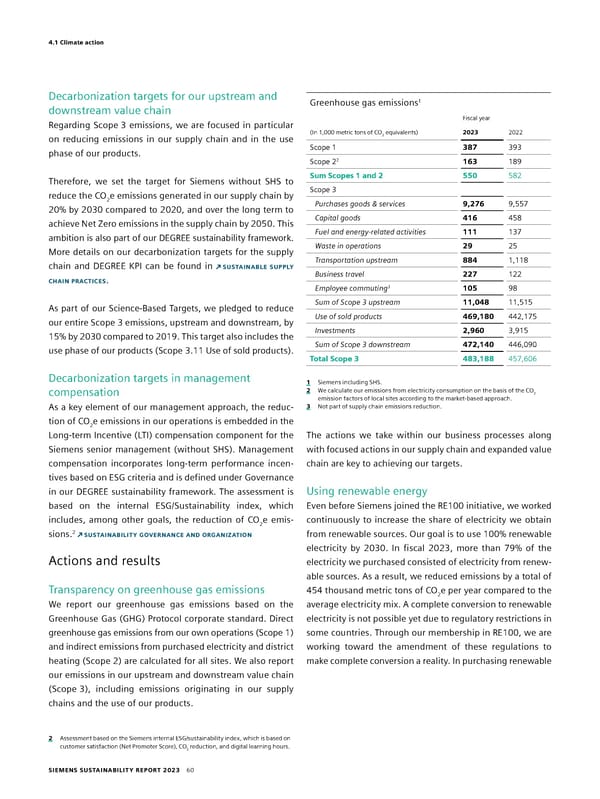4.1 Climate action Decarbonization targets for our upstream and 1 downstream value chain Greenhouse gas emissions Regarding Scope 3 emissions, we are focused in particular Fiscal year (In 1,000 metric tons of CO equivalents) 2023 2022 on reducing emissions in our supply chain and in the use 2 phase of our products. Scope 1 387 393 Scope 22 163 189 Therefore, we set the target for Siemens without SHS to Sum Scopes 1 and 2 550 582 reduce the CO e emissions generated in our supply chain by Scope 3 2 Purchases goods & services 9,276 9,557 20% by 2030 compared to 2020, and over the long term to Capital goods 416 458 achieve Net Zero emissions in the supply chain by 2050. This Fuel and energy-related activities 111 137 ambition is also part of our DEGREE sustainability framework. Waste in operations 29 25 More details on our decarbonization targets for the supply Transportation upstream 884 1,118 chain and DEGREE KPI can be found in SUSTAINABLE SUPPLY Business travel 227 122 CHAIN PRACTICES. Employee commuting3 105 98 As part of our Science-Based Targets, we pledged to reduce Sum of Scope 3 upstream 11,048 11,515 our entire Scope 3 emissions, upstream and downstream, by Use of sold products 469,180 442,175 15% by 2030 compared to 2019. This target also includes the Investments 2,960 3,915 use phase of our products (Scope 3.11 Use of sold products). Sum of Scope 3 downstream 472,140 446,090 Total Scope 3 483,188 457,606 Decarbonization targets in management 1 Siemens including SHS. 2 We calculate our emissions from electricity consumption on the basis of the CO compensation emission factors of local sites according to the market-based approach. 2 As a key element of our management approach, the reduc- 3 Not part of supply chain emissions reduction. tion of CO e emissions in our operations is embedded in the 2 Long-term Incentive (LTI) compensation component for the The actions we take within our business processes along Siemens senior management (without SHS). Management with focused actions in our supply chain and expanded value - chain are key to achieving our targets. compensation incorporates long-term performance incen tives based on ESG criteria and is defined under Governance in our DEGREE sustainability framework. The assessment is Using renewable energy based on the internal ESG/Sustainability index, which Even before Siemens joined the RE100 initiative, we worked includes, among other goals, the reduction of CO e emis- continuously to increase the share of electricity we obtain 2 sions.2 SUSTAINABILITY GOVERNANCE AND ORGANIZATION from renewable sources. Our goal is to use 100% renewable electricity by 2030. In fiscal 2023, more than 79% of the Actions and results electricity we purchased consisted of electricity from renew- able sources. As a result, we reduced emissions by a total of Transparency on greenhouse gas emissions 454 thousand metric tons of CO e per year compared to the 2 We report our greenhouse gas emissions based on the average electricity mix. A complete conversion to renewable Greenhouse Gas (GHG) Protocol corporate standard. Direct electricity is not possible yet due to regulatory restrictions in greenhouse gas emissions from our own operations (Scope 1) some countries. Through our membership in RE100, we are and indirect emissions from purchased electricity and district working toward the amendment of these regulations to heating (Scope 2) are calculated for all sites. We also report make complete conversion a reality. In purchasing renewable our emissions in our upstream and downstream value chain (Scope 3), including emissions originating in our supply chains and the use of our products. 2 Assessment based on the Siemens internal ESG/sustainability index, which is based on customer satisfaction (Net Promoter Score), CO reduction, and digital learning hours. 2 SIEMENS SUSTAINABILITY REPORT 2023 60
 Sustainability Report Page 59 Page 61
Sustainability Report Page 59 Page 61